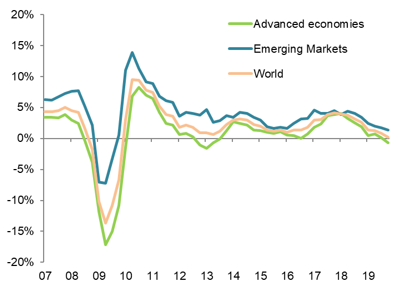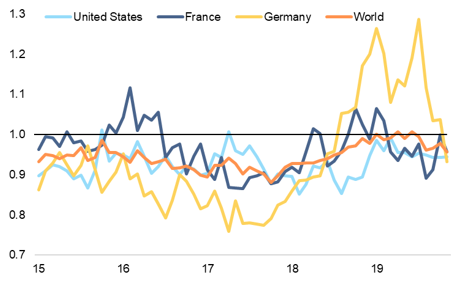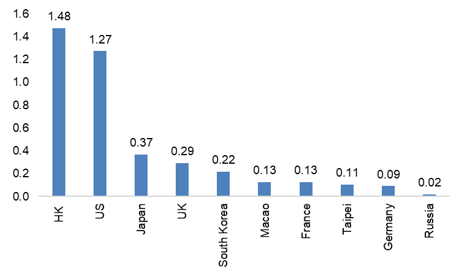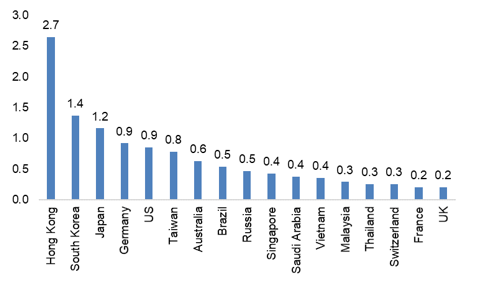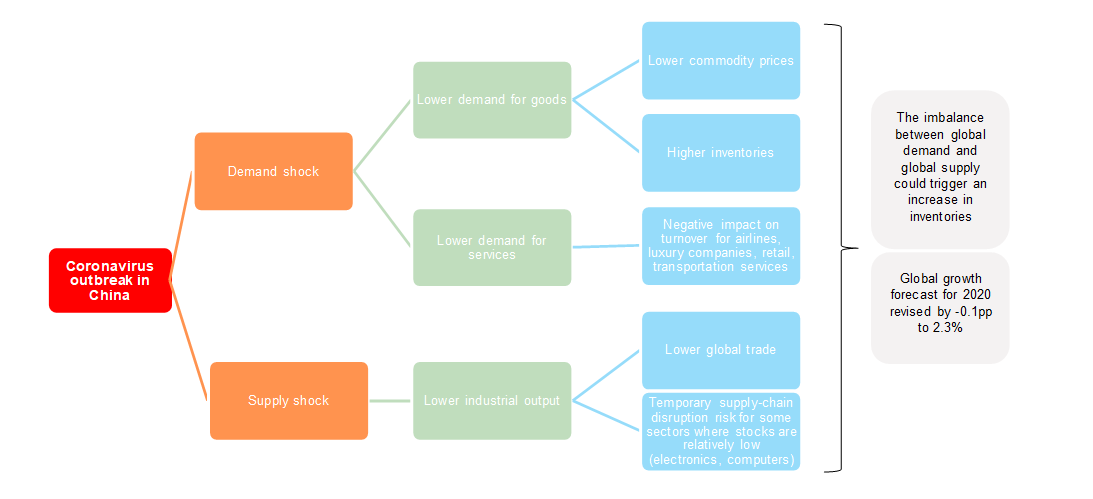Following last week’s estimate of the economic impact on China, this week, we look into the impact on the rest of the world: manufacturing and trade recessions are likely to continue, with a trade shock of USD26bn per week from the lockdowns in China (which should end on 9 February at the earliest), and global growth barely staying afloat at +2% in Q1 2020.
First, the coronavirus outbreak is likely to keep the manufacturing sector in recession in H1 2020. Electronics and computers are most at risk. With the business interruption in China caused by the coronavirus epidemic, — which has put several sectors at risk of supply chain disruption (read more here) and lower global demand — above long-term average stocks could increase further in sectors such as textiles, machinery and transport equipment and commodities. Meanwhile, goods’ shortages are a risk in sectors with below long-term average stocks (electronics, computers). In 2019, companies’ unusually high levels of stocks pushed manufacturing production into recession, notably in the advanced economies. With the stock absorption over the past few months being only partial, the lower global demand and the higher uncertainty are likely to push inventories up in the coming months. Hence, we expect the global manufacturing sector to remain in (shallow) recession in H1 2020.
Second, potential losses of exports of goods and services to China could amount to USD26bn per week as production and trade are paused. We have revised down our global trade growth forecast for 2020 by -0.5pp to +1.3%. Hong Kong, the U.S., Japan, South Korea and Germany are most exposed. This weekly loss is equivalent to a raise in the world import tariff on goods by +1pp in 2020, that is to say more than the effect of the U.S.-China trade feud in 2019 (0.7pp). In terms of goods, the most exposed countries are Hong Kong, South Korea, Japan, Germany and the U.S. The cost could be USD18bn weekly. In terms of services, travel expenses from China represent 20% of the world’s total, against 11% for the U.S. and around 30% for Europe. This represents around USD6bn per week in potential losses for the world, with Hong Kong, the U.S., Japan, the UK and South Korea the most impacted. In addition, losses linked to transportation services (imports from China) could reach USD2bn per week. This acute trade shock should last at least till 9 February.
Last, the macroeconomic impact should remain contained (-0.3pp on global GDP growth in Q1 2020 to +2%), if the business interruption in China doesn’t last for more than one month and business activity returns to normal after three months. While we think that the negative spillovers from the coronavirus epidemic will not last for more than three months, we doubt the global economy is strong enough to catch up entirely after the loss, given that the growth acceleration in H2 will be capped by U.S.-driven uncertainty. Overall, we think the recession in the manufacturing sector and global trade in goods will be prolonged into H1. Hence, we have revised our 2020 global GDP growth forecast by -0.1pp to +2.3%, based on a revised forecast for China (+5.6%, i.e. -0.3pp), the Eurozone (+0.9%, i.e. -0.1pp) and several other economies (Hong Kong, Singapore, South Korea, Japan, Taiwan, Thailand, Australia). We expect monetary policies to remain very active, with the ECB and the Fed even more likely to implement another rate cut in H1 2020, given that the “isolation” of China amid the coronavirus outbreak is likely to have strong negative impacts on both trade in goods and services.

